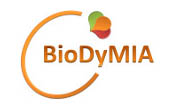2011 (02): "Antibacterial properties characterization of functionalized textiles with silver or PolyHexaMethylene Biguanide (PHMB)" (thesis by Elise CHADEAU)
This thesis was defended on February 15th, 2011.
Read the thesis online (French only)Thesis supervisor :
Dr N. Oulahal, Pr P. Degraeve .Funding :
Doctoral Research Grant in the Rhône-Alpes region (1/12 / 2007- 30/11/2010)
Collaborative Research and Development Project (Single Interministerial Fund (FUI)) - ACTIPROTEX
Doctoral school :
Ecole Doctorale Interdisciplinaire Sciences-Santé, ED n°205, LyonSummary:
Adhesion of pathogenic or spoilage microorganisms on the surfaces present in food industry can lead to contaminations of foods. Besides the economical impact for this industrial sector, these contaminations might alleviate food quality and hygiene and affect public health. Professional clothes constitute one of the vectors of contamination by the staff of food-processing industry. This work is a part of a collaborative project (Actiprotex) and concerns the evaluation of the antimicrobial activity of antimicrobial textiles developed for the hospital sector and the food-processing industry. Three methodologies were employed to obtain deposits of antimicrobial agents on textiles surfaces: plasma (PVD / PECVD) or sol-gel methodologies for the silver deposit and spin coating with a solution containing laurylsulfate and PolyHexamethylene Biguanide (PHMB). The antimicrobial activities of functionalized textiles were estimated after 24 hours of contact (according to the standard ISO 20743- 2005). The quantities of antimicrobial agent at the extreme surface of the textiles were estimated by two techniques of analyses of surface: the photoelectronic spectroscopy by X-rays (XPS) and the mass spectrometry of secondary ions (ToF-SIMS). Textiles functionalized by plasma methodology with silver were effective against Listeria innocua LRGIA 01. For the textiles functionalized by sol-gel methodology, the tested textiles were also very active towards L. innocua LRGIA 01 and Escherichia coli XL1 blue. However, E. coli XL1 blue seemed to be more sensitive to the silver on textiles than the L. innocua LRGIA 01 strain. Textiles treated with the PHMB also turned out to be very active towards L. innocua LRGIA 01 and Staphylococcus aureus methi-R nosoco 3011, however viable but not cultivable cell (VNC) were also revealed after contact of these 2 strains with the PHMB treated textile. Pseudomonas aeruginosa ATCC 15742 was more resistant to PHMB than these 2 strains. The washing resistance of silver- or PHMB-deposits was also estimated. Most of the silver deposit following plasma treatment was washed out while the PHMB deposit turned out to resist to 10 industrial washes. To understand the mechanism of action of the PHMB against L. innocua LRGIA 01, three approaches were considered: the epifluorescence microscopy in the presence of fluorescent dyes to estimate the state of the membrane cells, spectrofluorimetry in the presence of fluorescent probes (DPH and TMA-DPH) to estimate the membrane fluidity of cells and finally the infrared transformed Fourier spectroscopy (IRTF) to estimate the changes of conformation of the membrane



 en
en fr
fr